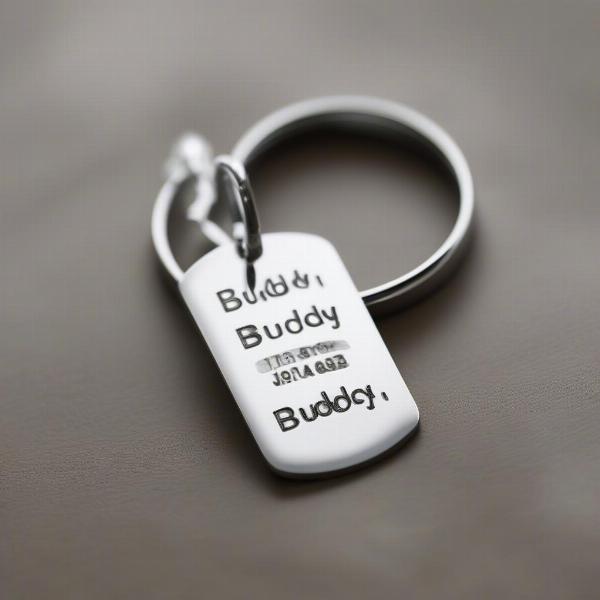Ensuring your dog’s safety and quick return if they ever get lost is a top priority for every pet owner. This brings us to the crucial question: what to put on a dog tag? A properly engraved dog tag is more than just a stylish accessory; it’s a lifeline that can reunite you with your beloved companion. This article will guide you through the essential information to include on your dog’s tag, legal requirements, and tips for choosing the right tag for your furry friend.
Essential Information for Every Dog Tag
What information is absolutely crucial for a dog tag? At a minimum, your dog’s tag should include their name and your phone number. This allows anyone who finds your dog to contact you immediately. A clear and easily readable phone number is paramount. Consider adding your city and state, especially if you live near state borders or frequently travel with your dog.
 Dog Tag with Name and Phone Number
Dog Tag with Name and Phone Number
While a name and phone number are essential, adding extra details can significantly increase the chances of a swift reunion. Including your address, while optional, provides another way for someone to return your dog, even if they can’t reach you by phone.
Legal Requirements and Considerations
What are the legal obligations regarding dog tags? In many places, it’s legally required for dogs to wear a tag with their rabies vaccination information. This helps animal control authorities verify your dog’s vaccination status if they are found roaming. Microchipping is also a legal requirement in some areas and a highly recommended practice, providing a permanent form of identification.
Even if rabies information isn’t legally required on your dog’s tag, it’s still a good idea to include it. This reassures anyone who finds your dog that they are vaccinated and safe to handle. If you are in the UK, you can refer to our article what to put on dog tag uk law for specific legal requirements. If you need help attaching the tag, check out how to put tag on dog collar.
Choosing the Right Dog Tag: Material, Size, and Style
What factors should you consider when selecting a dog tag? Dog tags are available in various materials, including stainless steel, aluminum, and plastic. Consider your dog’s lifestyle and choose a durable material that can withstand their activities. Size is also important. A tag that’s too large can be cumbersome, while a tag that’s too small can be difficult to read.
“Choosing the right dog tag goes beyond just the information engraved on it,” says Dr. Emily Carter, DVM. “Consider your dog’s size, activity level, and the environment they’re in. A sturdy, appropriately sized tag is essential for its longevity and readability.” Beyond functionality, dog tags can also be a fashion statement. Choose a style that reflects your dog’s personality, whether it’s a simple, classic design or a more playful and colorful tag.
Tips for Keeping Your Dog’s Tag Information Up-to-Date
How can you maintain the accuracy of your dog’s tag? It’s crucial to update your dog’s tag whenever your contact information changes. If you move or change phone numbers, make sure to get a new tag with the updated information. Regularly check the tag for wear and tear. A worn or faded tag can be difficult to read, so replace it as needed.
“Remember, a dog tag is only effective if the information is accurate,” advises certified dog trainer, Mark Johnson. “Make it a habit to check your dog’s tag regularly and update it as needed. This simple step can make a world of difference in reuniting with your lost pet.” For more information specific to the UK, refer to what to put on dog tag uk.
Conclusion
A dog tag is a small but vital piece of equipment for every dog owner. By including the essential information, considering legal requirements, and choosing the right tag for your dog, you can significantly increase the chances of a quick and happy reunion if your furry friend ever gets lost. Remember to keep your dog’s tag information updated to ensure its effectiveness.
FAQ
- Is it necessary to put my address on my dog’s tag? While not always required, including your address can be helpful, especially if you live in a rural area or your phone number is unavailable.
- What if my dog’s tag gets lost? Consider using a tag silencer to prevent jingling and reduce the risk of the tag getting caught and pulled off.
- What material is best for a dog tag? Stainless steel is a popular choice due to its durability and resistance to rust and corrosion.
- Can I put my dog’s medical information on their tag? While you can include brief medical information, such as “Diabetic” or “Needs Medication,” it’s more important to prioritize contact information.
- Where can I get my dog’s tag engraved? Pet stores, online retailers, and even some veterinarians offer dog tag engraving services.
- How can I prevent my dog’s tag from fading? Choose high-quality tags made from durable materials like stainless steel and avoid using harsh chemicals when cleaning them.
- What should I do if I find a dog with a tag? Contact the owner using the phone number on the tag immediately.
ILM Dog is your trusted resource for expert advice on dog care, offering guidance on everything from breed selection to health, training, nutrition, grooming, and much more. Our extensive collection of articles provides valuable insights for both new and experienced dog owners. We also offer a range of specialized products to enhance your dog’s well-being, including dog incontinence nappies and luxurious dog silk pajamas. For personalized advice or any dog-related inquiries, reach out to our expert team at [email protected] or call us at +44 20-3965-8624. ILM Dog is committed to providing you with the best resources and support for a happy and healthy canine companion.